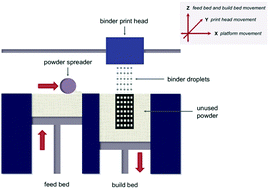当前位置:
X-MOL 学术
›
Biomater. Sci.
›
论文详情
Our official English website, www.x-mol.net, welcomes your
feedback! (Note: you will need to create a separate account there.)
3D printed porous ceramic scaffolds for bone tissue engineering: a review
Biomaterials Science ( IF 5.8 ) Pub Date : 2017-06-23 00:00:00 , DOI: 10.1039/c7bm00315c Yu Wen 1, 2, 3, 4, 5 , Sun Xun 1, 2, 3, 4, 5 , Meng Haoye 1, 2, 3, 4, 5 , Sun Baichuan 1, 2, 3, 4, 5 , Chen Peng 1, 2, 3, 4, 5 , Liu Xuejian 1, 2, 3, 4, 5 , Zhang Kaihong 1, 2, 3, 4, 5 , Yang Xuan 1, 2, 3, 4, 5 , Peng Jiang 1, 2, 3, 4, 5 , Lu Shibi 1, 2, 3, 4, 5
Biomaterials Science ( IF 5.8 ) Pub Date : 2017-06-23 00:00:00 , DOI: 10.1039/c7bm00315c Yu Wen 1, 2, 3, 4, 5 , Sun Xun 1, 2, 3, 4, 5 , Meng Haoye 1, 2, 3, 4, 5 , Sun Baichuan 1, 2, 3, 4, 5 , Chen Peng 1, 2, 3, 4, 5 , Liu Xuejian 1, 2, 3, 4, 5 , Zhang Kaihong 1, 2, 3, 4, 5 , Yang Xuan 1, 2, 3, 4, 5 , Peng Jiang 1, 2, 3, 4, 5 , Lu Shibi 1, 2, 3, 4, 5
Affiliation

|
This study summarizes the recent research status and development of three-dimensional (3D)-printed porous ceramic scaffolds in bone tissue engineering. Recent literature on 3D-printed porous ceramic scaffolds was reviewed. Compared with traditional processing and manufacturing technologies, 3D-printed porous ceramic scaffolds have obvious advantages, such as enhancement of the controllability of the structure or improvement of the production efficiency. More sophisticated scaffolds were fabricated by 3D printing technology. 3D printed bioceramics have broad application prospects in bone tissue engineering. Through understanding the advantages and limitations of different 3D-printing approaches, new classes of bone graft substitutes can be developed.
中文翻译:

用于骨组织工程的3D打印多孔陶瓷支架:综述
这项研究总结了三维(3D)打印多孔陶瓷支架在骨组织工程中的最新研究现状和发展。综述了有关3D打印的多孔陶瓷支架的最新文献。与传统的加工和制造技术相比,3D打印的多孔陶瓷支架具有明显的优势,例如增强了结构的可控制性或提高了生产效率。更复杂的支架是通过3D打印技术制造的。3D打印生物陶瓷在骨组织工程中具有广阔的应用前景。通过了解不同3D打印方法的优点和局限性,可以开发出新型的骨移植替代品。
更新日期:2017-08-22
中文翻译:

用于骨组织工程的3D打印多孔陶瓷支架:综述
这项研究总结了三维(3D)打印多孔陶瓷支架在骨组织工程中的最新研究现状和发展。综述了有关3D打印的多孔陶瓷支架的最新文献。与传统的加工和制造技术相比,3D打印的多孔陶瓷支架具有明显的优势,例如增强了结构的可控制性或提高了生产效率。更复杂的支架是通过3D打印技术制造的。3D打印生物陶瓷在骨组织工程中具有广阔的应用前景。通过了解不同3D打印方法的优点和局限性,可以开发出新型的骨移植替代品。











































 京公网安备 11010802027423号
京公网安备 11010802027423号